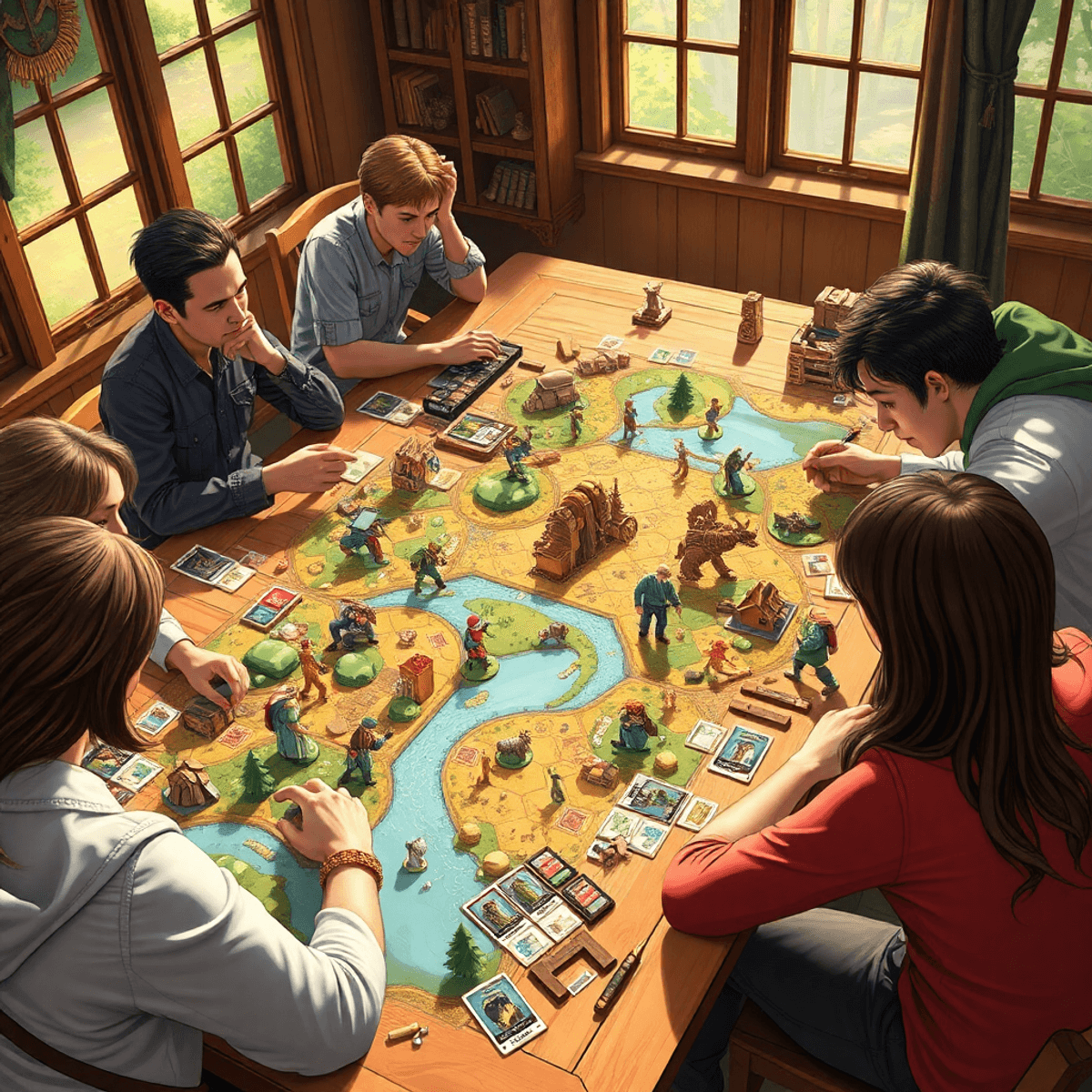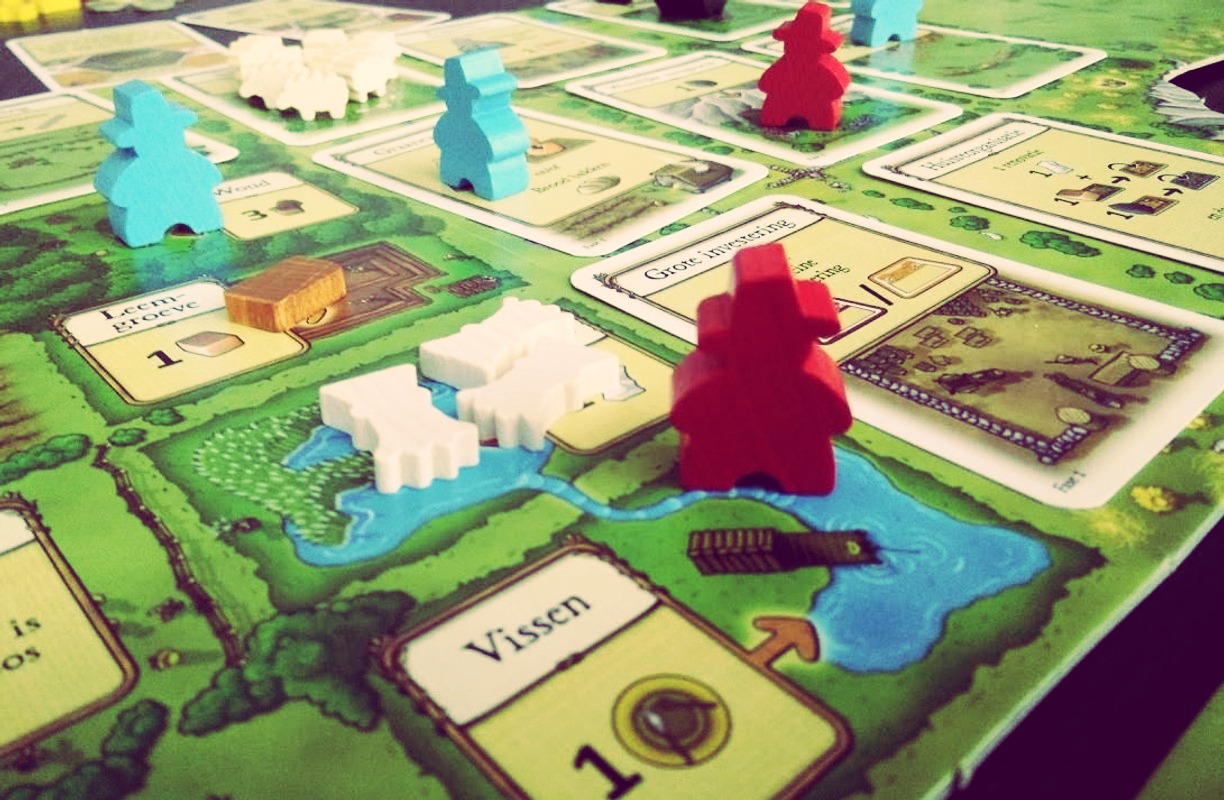
Action selection is an important mechanic in modern board gaming. It influences player decisions and adds strategic depth to many games. This system allows players to choose from available actions during their turn, making each decision meaningful and encouraging interaction between players. This article explains all about the evolution of worker placement games.
The Evolution of Action Selection: Worker Placement Games
Worker placement games are a specific type of action selection mechanic. In these games, players must assign their limited workforce to specific spots on the board. This introduces new challenges such as spatial competition and resource optimization that players find exciting.
From the groundbreaking Caylus to contemporary hits like Everdell, worker placement has grown into a sophisticated gaming mechanism that continues to inspire innovation in game design.
This article explores the history of action selection mechanics, focusing on worker placement games. We’ll discuss:
- The development of these mechanics over time
- Important games that influenced the genre
- Strategies for becoming skilled at worker placement
- Recent innovations in the field
- Recommendations for games that showcase this mechanic
Whether you’re an experienced gamer or just starting out with worker placement, this guide will help you understand and appreciate this influential gaming mechanism.
The Rise of Action Selection Mechanics in Board Games
Action selection mechanics represent a fundamental system where players choose specific actions from a limited pool of options during their turn. This core mechanic creates engaging decision-making moments and strategic depth in gameplay.
The early 2000s marked a significant shift in board game design with the introduction of role selection mechanics. Puerto Rico (2002) stands as a pioneering title that revolutionized action selection through its innovative role-based system:
- Players select roles that grant primary actions
- Each chosen role affects all players at the table
- The selecting player gains additional benefits
- Unavailable roles receive bonus incentives
This design created intricate layers of strategy:
- Timing considerations for role selection
- Reading opponents’ needs and intentions
- Balancing personal gain against group benefit
- Managing scarce resources through careful action choices
The success of Puerto Rico’s mechanics inspired numerous designers to explore new possibilities in action selection. Games like San Juan (2004) and Race for the Galaxy (2007) built upon this foundation by introducing simultaneous action selection and card-based variations.
These early innovations laid crucial groundwork for the development of more sophisticated action selection systems, pushing the boundaries of strategic gameplay and player interaction in modern board game design.
The Birth and Evolution of Worker Placement Games
The release of Caylus in 2005 marked a significant moment in board game history. Designer William Attia introduced a groundbreaking mechanic that would reshape modern game design: true worker placement. The game’s innovative system featured physical worker meeples that players strategically positioned on various action spaces along a medieval construction site.
Core Elements Defined by Caylus
Caylus established several core elements that define worker placement games:
- Limited Action Spaces: Each spot accommodates only one worker
- Turn Order Significance: The sequence of placement affects strategic options
- Resource Management: Workers generate materials needed for construction
- Blocking Mechanics: Players can deny opponents access to crucial actions
The game’s success sparked a creative explosion in the industry. Agricola (2007) built upon these foundations, introducing a farming theme and expanding worker placement possibilities. Designer Uwe Rosenberg integrated:
- Complex resource chains
- Feeding requirements for workers
- Variable player powers through occupation cards
- Multiple paths to victory
Tension through Scarcity
Agricola’s innovations demonstrated the versatility of worker placement mechanics. The game created tension through scarcity – each round presented more options than available workers, forcing players to make challenging decisions about resource allocation and timing.
Rapid Experimentation (2007-2010)
The period between 2007-2010 saw rapid experimentation with the worker placement formula. Games like Stone Age introduced dice-based worker actions, while Le Havre expanded resource conversion possibilities. These titles proved that worker placement could adapt to various themes and complexity levels while maintaining its core appeal: meaningful choices and player interaction.
Flexibility in Design
The mechanic’s flexibility allowed designers to create unique experiences by adjusting key variables:
- Number of available workers
- Action space quantity
- Resource complexity
- Blocking rules
- Victory conditions
This adaptability established worker placement as a fundamental mechanic in modern board game design, inspiring countless innovations in subsequent years.
Expanding the Genre: Accessibility and Innovation in Worker Placement Games
The release of Lords of Waterdeep in 2012 marked a significant shift in worker placement game design. Its streamlined mechanics and engaging Dungeons & Dragons theme created an ideal entry point for newcomers to the genre. The game’s intuitive design replaced complex resource management with a straightforward quest completion system, while maintaining strategic depth through:
- Clear, color-coded buildings and quests
- Simple worker deployment rules
- Transparent scoring mechanisms
- Engaging player interaction through intrigue cards
Modern worker placement games have pushed creative boundaries by incorporating hybrid mechanics. Everdell combines traditional worker placement with card-based engine building, creating a unique ecosystem where players:
- Deploy workers to gather resources
- Build structures and recruit creatures
- Create powerful card combinations
- Manage seasonal cycles affecting worker availability
Dune: Imperium represents another innovative approach, seamlessly blending worker placement with deck building mechanics. Players must:
- Strategic card play determines available actions
- Workers compete for limited board spaces
- Resource management affects both deck and worker efficiency
- Conflict resolution adds player interaction
These hybrid designs have expanded the genre’s appeal while maintaining core worker placement principles. Games like Raiders of the North Sea introduced unique twists with its place-and-pick mechanic, where players both place and remove workers during their turns. Architects of the West Kingdom reimagined worker accumulation, allowing multiple workers in single spaces and creating new strategic considerations for timing and resource optimization.
Mastering Worker Placement: Strategy Tips for Success
Success in worker placement games demands a blend of tactical thinking and strategic planning. Here are key strategies to enhance your gameplay:
1. Turn Order Optimization
- Securing early turn positions grants first access to crucial action spaces
- Late turn positions can offer bonus resources or special abilities
- Adapt your strategy based on your position in the turn order
2. Tactical Blocking
- Place workers strategically to deny opponents access to vital resources
- Identify your opponents’ needs and block accordingly
- Consider alternative actions when your preferred spots are blocked
3. Resource Management
- Build a sustainable economy before pursuing victory points
- Balance short-term gains against long-term objectives
- Maintain flexibility in your resource gathering strategy
4. Player Interaction
- Study your opponents’ tableau and board state
- Anticipate competitor moves to adjust your strategy
- Create mutually beneficial arrangements when appropriate
5. Action Efficiency
- Maximize the value of each worker placement
- Chain actions together for compound benefits
- Time your big moves for optimal impact
The depth of worker placement games stems from the constant tension between pursuing your strategy and disrupting others’. Players must remain adaptable, ready to pivot when their primary plans are blocked while maintaining focus on their end-game objectives. This dynamic interplay creates engaging gameplay experiences that reward both tactical awareness and strategic planning.
Comparing Worker Placement and Action Selection Mechanics: A Game Design Perspective
Worker placement and action selection mechanics share DNA but create distinct player experiences. Action selection offers players a menu of choices each turn, like selecting roles in Puerto Rico or choosing actions in Race for the Galaxy. These games emphasize timing and role synergies without physical space limitations.
Worker placement adds spatial competition through physical pieces – “workers” placed on specific board locations. This creates a tangible sense of territory control and resource scarcity. Games like Caylus and Stone Age demonstrate how physical worker placement generates direct player interaction through spot-blocking and turn order manipulation.
Key distinctions between these mechanics:
- Physical Space: Worker placement requires managing limited board spaces, while action selection focuses on choosing from available options
- Player Interaction: Worker placement creates immediate conflict through spot-blocking, while action selection interaction is often indirect
- Resource Management: Worker placement typically ties actions to specific locations and resources, creating tighter economic constraints
- Scalability: Action selection often scales better with player count, while worker placement games need careful space balancing
The psychological impact also differs. Worker placement creates tension through visible competition for spots, while action selection builds anticipation through role selection timing. Both mechanics excel at different aspects of strategic depth – worker placement through spatial puzzles, action selection through timing and efficiency optimization.

Influence of Worker Placement on Modern Game Design Trends
Worker placement mechanics have transformed modern board game design, creating ripple effects across multiple genres. This versatile mechanic now appears in unexpected places, from family-weight games to complex strategic experiences.
The integration of worker placement into cooperative games marks a significant evolution. Games like Pandemic: Rapid Response demonstrate how shared worker pools create tension and foster team decision-making. Players must carefully coordinate their actions while managing limited worker resources, adding depth to cooperative gameplay.
Beyond Eurogames: The Expanding Influence of Worker Placement
Worker placement’s influence extends beyond traditional Eurogames:
- Hybrid Designs: Games like Raiders of the North Sea combine worker placement with unique mechanics where players both place and remove workers, creating dynamic gameplay loops
- Thematic Integration: Champions of Midgard meshes worker placement with dice combat, proving the mechanic’s adaptability to combat-focused games
- Legacy Elements: Charterstone incorporates worker placement into a campaign format, showing how the mechanic can evolve throughout multiple gaming sessions
Spatial Innovations: Redefining Worker Placement
The mechanic’s flexibility has inspired designers to experiment with spatial elements. The Manhattan Project: Energy Empire uses area control alongside worker placement, while Everdell introduces a three-dimensional board space that affects worker placement options.
This adaptability has led to innovative game designs where worker placement serves as a foundation for mechanical experimentation rather than the sole focus. Modern designers increasingly view worker placement as a tool to enhance player engagement rather than a strict framework to follow.
Future Developments in Action Selection Mechanics Within Board Games
The future of action selection mechanics promises exciting innovations that could reshape how we experience board games. Digital integration stands as a frontier, with hybrid games potentially incorporating app-driven worker placement systems that adapt to player decisions in real-time.
Virtual and augmented reality technologies might transform traditional worker placement into immersive experiences, allowing players to physically interact with 3D game spaces and workers. This technological leap could blur the lines between digital and analog gaming while maintaining the core strategic elements that make these mechanics engaging.
We’re likely to see:
- AI-Enhanced Systems – Sophisticated solo modes with adaptive difficulty
- Dynamic Board States – Modular boards that physically transform during gameplay
- Cross-Platform Integration – Seamless transitions between physical and digital play sessions
- Social Integration – Connected experiences allowing for asynchronous worker placement across different time zones
The evolution of action selection mechanics might also embrace accessibility features, incorporating tactile elements and audio cues to make these games more inclusive for players with different abilities.




